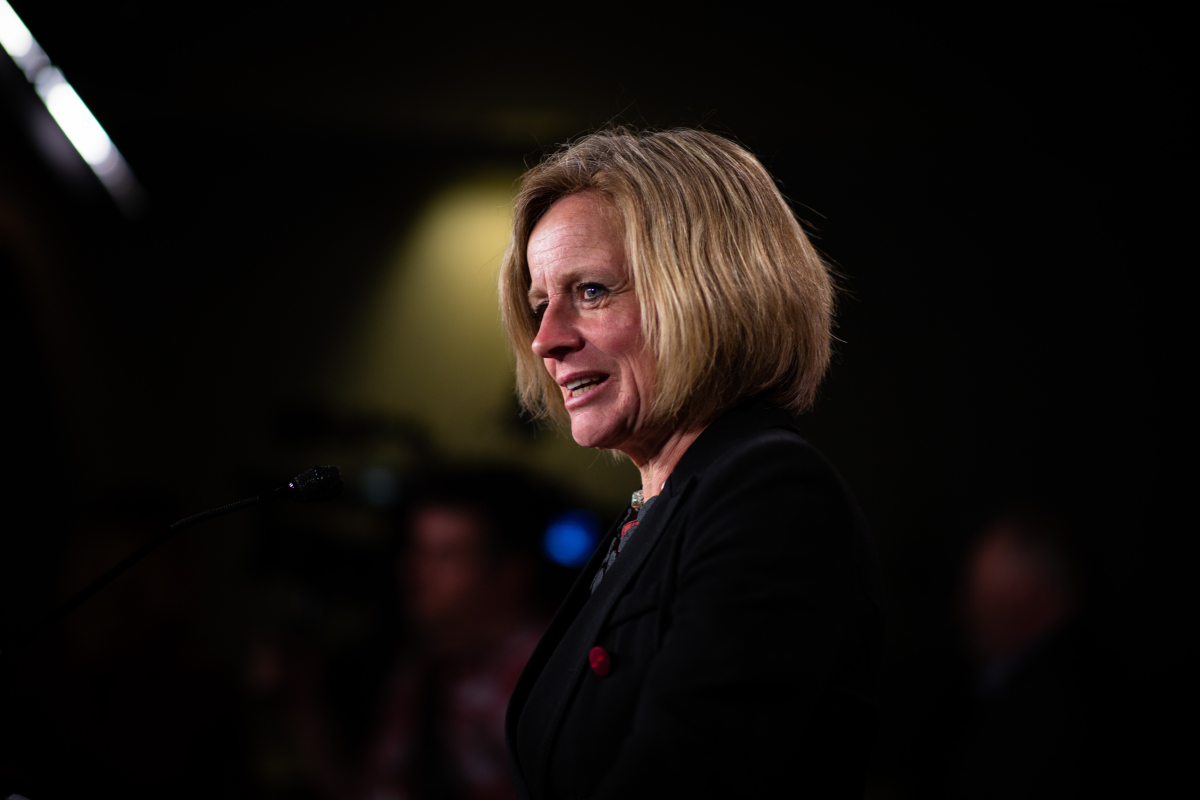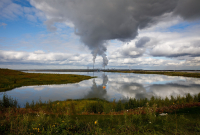Alberta Premier Rachel Notley is aggressively advancing a false narrative about heavy oil’s deep discount. She presents the problem in two parts, neither of which stand up to scrutiny.
First, Notley purports that the abnormally wide price spread affects every barrel of heavy oil leading to millions of dollars a day in losses to the Canadian economy. And second, that the Trans Mountain pipeline expansion is crucial. Neither of these claims are supported by the facts.
Most Alberta oil is sheltered from the price discount
When you crunch the numbers, and include the variety of methods even the smaller players rely on to protect their exposure including long-term supply arrangements, hedging and access to rail, it turns out that only about 20 per cent of oilsands supply is actually affected by the light-heavy differential.
WTI is West Texas Intermediate light oil priced in Cushing, Oklahoma and WCS is Western Canadian Select heavy oil priced in Hardisty, Alberta. The WTI-WCS spread is referred to as the light-heavy differential.
Alberta’s heavy oil is a low-quality crude that always sells at a discount to lighter, higher quality oil. It costs money to deliver it to Cushing which further reduces its price. The natural discount for quality and transportation is $15 US to $20 US per barrel which means if WTI is selling for $50 US a barrel we would expect WCS to sell for about $30 US to $35 US a barrel.
However, even as WTI hovers around $50 US a barrel, the discount for WCS has fallen below the normal range for quality and transportation. The problem is, Notley claims the abnormal spread affects every barrel when relatively few barrels are actually exposed. Notley’s claim is based on an egregious error about how the market works. Oil producers have implemented price protection business strategies that ensure hardly any barrels are affected at all.
Notley has frequently repeated this story since last spring when she started alarming the public claiming that the heavy oil discount was costing the Canadian economy $15 billion a year — $40 million a day. That estimate was lifted from a report prepared by Scotiabank which is replete with errors and it is a huge mistake to use that one report as the entire basis for any claim.
Last week, Notley doubled the figure to $80 million a day and launched a Canada-wide ad campaign, including a Real Time Revenue Loss Calculator located near Parliament Hill.
I asked the Alberta government how the $80 million a day was calculated and was advised that Notley once again relied on the flawed Scotiabank report.
We’ve heard these false claims before
It reminds me of a similar false narrative advanced in support of the Northern Gateway pipeline proposal, way back in 2012. A CIBC analyst claimed there was a $50 million a day loss because Northern Gateway was not built. When I asked for the calculation he did not have it. Natural Resources Minister, Joe Oliver aggressively relied on the figure in public statements. I asked Natural Resources Canada for their calculation and was given a run around. Eventually, an after-the-fact calculation was provided that made little sense.
This didn’t stop the Canadian Chamber of Commerce from releasing a pamphlet in September 2013 claiming that same $50 million a day loss. That document was paid for by industry, including Kinder Morgan. I checked with the Chamber of Commerce. They did not confirm how the figure was derived but said they relied on sources like CIBC and Oliver.
Flawed analysis makes Notley’s numbers meaningless
Notley relies on the Scotiabank report which attempts to put some analysis behind its figure, but Scotiabank misrepresented how the market for crude oil actually works. Scotiabank mistakenly applied the discount to all barrels supplied as if they are all exposed to spot market pricing when relatively few are.
What matters is not the size of the discount, but the number of barrels exposed to it. Reliance on a flawed Scotiabank analysis renders Notley’s claim meaningless.
Take for example the integrated operations of major oil producers active in the Alberta economy. Scotiabank would have Canadians believe that when Suncor, Husky and Imperial sell the crude they produce to their refineries in Canada, they suffer a loss. They don’t. They make profits in their refinery operations — in Canada — as if they paid the international benchmark price, Brent, for their feedstock.
Scotiabank would also have us believe that when other Canadian refiners — such as Regina Co-op, in Saskatchewan, or Parkland in B.C. — buy discounted crude, that this is a loss to the Canadian economy, when it is a clear gain.
Since Scotiabank “forgot” that we have a refinery sector in Canada, this error alone overstated the number of barrels it subjected to its "loss" estimate by about 20 per cent. I asked Scotiabank about this. I was told that their report was not intended to be a cost benefit evaluation. When I said their report is presented as such, suddenly they had no further time for discussing the flaws in their analysis with me.
There are a number of other major flaws in Scotiabank’s report. When crude oil producers deliver barrels to the U.S. Gulf Coast those barrels receive a higher price not determined by the WTI-WCS discount. Therefore, these barrels are not exposed to it. We know this because oil producers who deliver to the Gulf tell their investors they receive global pricing based on Mexican Maya heavy oil. This means that even more of the barrels Scotiabank subjected to the discount are actually not affected by it.
Notley’s discount narrative presents big oil as if they have been caught totally unaware of market forces. Anyone who understands the buying and selling of Canada’s crude knows most barrels are protected from spot market pricing because major companies have spent years implementing business strategies to do so.
Imperial Oil CEO, Rich Kruger, explained to investors in July how Imperial protects production: “We continue to reduce our overall exposure to differentials, through our own refineries, contract pipe to the Gulf Coast and continued expanded use of rail … As I look to the second half of the year, I expect that we will be using more of it (rail), notionally targeting something in the 125,000 barrels a day of the roughly 210,000 barrel a day capacity of the facility (Kearl). Here again, it is allowing us to cost effectively, through the use of unit trains and our existing ownership in this facility, compete on a netback basis with pipe alternatives to get to markets. Again, primarily Texas, Louisiana, Gulf Coast and get the highest realization for our production.”
There are even more protection strategies from volatile spot market pricing. When crude oil producers enter into long-term contracts for space on pipelines such as Keystone and Express, they protect themselves with long term supply contracts with refiners. Producers will also enter into long-term supply contracts with refiners even when they rely on spot capacity for pipelines such as Enbridge mainline and Trans Mountain. The mid-west U.S. is the most significant market for western Canadian crude and many of the refineries rely on such arrangements with oil suppliers.
When Canadian oil producers supply crude to their own refineries in the U.S., they also keep the benefit. Cenovus has invested in two refineries south of the border rather than investing in value added in Canada. This protects many of the barrels they produce from an abnormal discount. Integrated U.S. refinery protection, along with long-term contracts and access to rail is why Cenovus can report to its shareholders that its exposure to the wider differential is mitigated for 55–60 per cent of the heavy barrels that the company produces.
How few barrels are actually exposed?
It is difficult to get an accurate estimate of the number of barrels that are exposed to the light-heavy differential. Suncor, Husky and Imperial are effectively not exposed, while Cenovus and Canadian Natural Resources are partially exposed. These five companies represent close to 80 per cent of heavy oil exported. Evaluating oilsands players individually and incorporating the strategies even the smaller players rely on to protect their exposure including long-term supply arrangements, hedging and access to rail, suggests that in aggregate no more than 400,000 barrels a day — or about 20 per cent — of oilsands supply is affected by the light-heavy differential.
The volume of supply exposed to the differential can vary depending on markets and other conditions. For example, when Keystone sprung a leak a year ago and was shut down, barrels under long term contract on that pipeline suddenly hit the spot market widening the differential significantly. The differential widened not because of a lack of pipeline capacity but because of a lack of pipeline integrity.
Keystone capacity came back on stream pretty quickly and the differential narrowed. But then it began to widen once again. Pipelines were not full, but capacity was becoming constrained. Oil producers continued to increase production into a transportation-constrained market. Oil producers brought a deeper discount on themselves. For many of the big players, the net impact would be beneficial.
Reality check on the need for new pipelines
The second part of the misleading narrative around the deep discount says the abnormally wide differential is due to one factor — a lack of pipeline capacity. Therefore, the spread can only be narrowed to its normal range by building Trans Mountain’s expansion. The problem is, other factors are driving the steep discount and excess pipeline capacity will be available long before Trans Mountain is ever built.
Earlier this year producers became more concerned about access to pipeline capacity. They began to nominate for pipeline space not only based on barrels they had available to ship, but for barrels they didn’t have. The industry has a term for these imaginary barrels — they call them “air barrels.”
The idea is that, if they over-nominate for pipeline capacity and the pipeline operator apportions the space, they will get all the space they could possibly need. The problem is, exaggerating the barrels they have available comes at a cost to the system and the Canadian economy. Over-nomination leads to unused capacity.
Pipeline space runs idle when oil producers abuse the system by nominating barrels they don’t have because Enbridge plans the batches as efficiently as possible at the beginning of the month, based on what the company was told. When those barrels don’t materialize, Enbridge is unable to replace them.
Enbridge Executive vice president, Guy Jarvis, explains the air barrel problem this way: “We find ourselves, mid-month, falling short on crude … we've got to … make sure that those barrels that are nominated and granted space are real so that we can move them … what we're seeing is that the throughput at the end of the month versus what we accepted for nominations is not matching up.”
Enbridge is reluctant to say how much space runs idle. Canadian Natural Resources estimated last spring that as much as 125,000 barrels a day of capacity on Enbridge Mainline is running empty because of air barrel nominations. Recent throughput statistics on Enbridge’s system suggest it could be closer to 150,000 barrels a day.
Enbridge’s inefficient use of its pipeline capacity is significant. It produces a serious widening of the differential because it takes relatively few barrels in the spot market to do so. If Enbridge were able to run its pipeline at a higher rate of throughput, the discount would narrow to a more natural range based on quality and transportation costs.
What’s stopping Enbridge from using its excess pipeline capacity?
In June of this year Enbridge attempted to stop the inappropriate nominations for space on its system. This prompted BP to file a complaint with the National Energy Board which triggered a flurry of letters from industry players. A review of the correspondence makes it clear that when Enbridge attempted to verify nominations under a new regime it created winners and losers. The winners under the old system were not interested in changing the setup.
If there were a genuine concern on the part of industry about a lack of capacity and harm from the discount, Enbridge’s flawed nomination process would have been corrected long ago. When this situation is more clearly understood, it makes Notley’s ad campaign and appointment of a special envoy to dig into the discount look cartoonish.
At Justin Trudeau’s press conference at the Alberta Chamber of Commerce in Calgary last Thursday, the prime minister picked up the $80 million a day figure and stated that oil producers “are forced to sell our oil at a discount.”
There is no forcing here. Nobody is making huge oil companies do anything. These companies are making Alberta and Ottawa do their bidding. Trudeau overpaid for an aging pipeline and the right to expand it so irresponsible producers can continue to exploit fossil fuels without constraint at a time when the world marketplace and global ecosystem is signaling it’s time to stop.
There are few barrels affected by the deep discount, and for those barrels that are, the deep discount is being driven by a flawed nomination process and industry players that refuse to figure out a way to fix it.
Even if Enbridge were able to stop the nomination of air barrels and efficiently use the capacity it has, expansion of oilsands production currently underway would see a return of constrained capacity. However, as the oil producers themselves tell us, this will be addressed by capacity expansions expected within the year.
Enbridge’s Line 3 Replacement project will be complete in the fall of 2019 bringing 370,000 barrels a day of capacity on stream. With other enhancements the company has announced, a further 400,000 barrels a day can be made available. Expanded capacity of close to 800,000 barrels a day means — under the current outlook for crude oil production into the next decade — Trans Mountain’s capacity is not needed.
Not only is Notley’s — and now Trudeau’s — $80 million a day deep discount narrative fundamentally flawed, the claim that only Trans Mountain’s expansion can solve it is also simply untrue.
If you’ve made it this far, you must care about in-depth and responsible journalism. How about supporting more articles like this one? Get 60% off your subscription today. Full access to Canada’s top investigations on energy, climate, the environment and more. If you’re already a subscriber, please consider gifting a subscription, just in time for the holiday season.







Comments
I am so glad Robyn Allan is keeping a close eye on this industry.
Even Postmedia has reported that not all of Canada's U.S. exports are subject to heavy discounts. Notley and Trudeau are deliberately misleading Canadians.
U.S. heavy-oil refineries on the Gulf Coast are paying top dollar for AB dilbit, just below the WTI price.
"What discount? Gulf Coast paying premium prices for Canadian oil — but only 450,000 bpd make it there"
• calgaryherald [dot] com/commodities/energy/what-discount-gulf-coast-paying-premium-prices-for-canadian-oil-but-only-450000-bpd-make-it-there/wcm/71f49e90-bfb7-40f8-9053-75167c8c696e
Keystone XL will transport 830,000 bpd of AB oil to Nebraska and Gulf Coast refineries.
"Roughly 80% of Suncor Energy Inc.’s bitumen production is fully insulated from the differentials, spokesperson Erin Rees said in an email.
"'And the other 20% is only potentially exposed due to the work of our marketing team, our significant midstream capacity and a vast logistics network we can leverage and for operational purposes,' she said.
"Husky Energy Inc. spokesperson Mel Duvall said his company owns more refining capacity than it can fill up with its own production, and is not negatively affected by WCS/WTI differentials."
• business [dot] financialpost [dot] com/commodities/oilpatch-scrambles-to-ship-distressed-barrels-as-industry-loses-100m-in-revenues-daily
"During AB’s so-called bitumen crisis, the 3 top oilsands producers — Suncor, Husky and Imperial Oil — are posting record profits. All 3 firms have succeeded this year because they own upgraders and refineries in Canada or the U.S. Midwest that can process the cheap bitumen or heavy oil into higher value petroleum products."
• thetyee [dot] ca/Analysis/2018/11/23/Alberta-Policy-Problems/
With the highest concentration of heavy-oil refineries in the world, the U.S. remains our best customer. AB oil reaches tidewater at the Gulf of Mexico (as well as the port of Vancouver). Overseas shipments of AB heavy oil remain few and far between.
When big U.S. mid-West refineries get back online after maintenance, and Keystone XL and Enbridge's Line 3 start up, the discount is expected to return to normal levels. (But watch out for IMO 2020.)
The hysteria that Notley is fuelling with her false claims and B.S. arguments to push pipelines is going to sweep the NDP away in 2019.
What is she thinking?
Very informative comment with links. Much appreciated by this reader.
Most grateful for Robyn Allan's devastating analysis, based on her intimate knowledge of the sector and its practices. There is, however, also a simple way of showing how unfounded the nearly uniform chorus is that links the discount to pipeline capacity: Imagine increased pipeline capacity; that would lead to more supply; by the law of supply and demand, the price would decline, not increase.
The degree of deception an group think is truly amazing.
Have you asked Chantal Hebert, Andrew Coyne and Rosemary Barton for comments on your article here? Listening to At Issue last night, it was like none of these issues existed.
Agreed. My wife and I also watched At Issue and were also disappointed. We had recently heard a talk by Andrew Nikiforuk ( https://albertapolitics.ca/2018/11/author-andrew-nikiforuk-tells-a-blea… ) and we knew that much was left out by the panel members. I would encourage everyone who agrees to send this article to the CBC and to Notley and Trudeau.
I wish someone would explain how supplying more product to a glutted market will somehow increase the price we get for the product.
As I said earlier: The degree of deception and group think is truly amazing. The G&M editorials on this issue are amazing, as if coming from a robot.
Thank you Robyn Allan. More detail and honesty than we'll ever get from the industry and Alberta captured Globe & Mail. Today's Globe is really over the top, I suspect because the industry in putting pressure on them and their wanting to curry favour in Alberta, in part to make the Feds look bad.
I have a a couple of question for you.
1. If the majors like Imperial who have refineries in the USA, what is the possibility that they are or will start imposing the large discount on WCS for their refinery operations thus reducing the income of Canadian operations to reduce taxes and put pressure on Alberta to reduce it's already low royalties further and take their profits in the USA where they likely have lower or no taxes via various accounting arrangements?
2. How many tankers that leave KM's facility in Burnaby for countries other than the USA. If I recall correctly, it is next to none. If so, why are they not shipping KM (or now TM) bitumen to these supposed huge markets Canadian oil firms are missing in Asia and elsewhere?
Send an e-mail asking for my detailed report on tankers at the Westridge Marine Terminal to [email protected]
You are creating a huge problem Rachel. Since the Lac Megantic disaster 5 years ago, the shipment of oil by rail has doubled. Yes, doubled from 123 BPD to 250 BPD. And the individuals responsible for moving the trains are overworked and are exhausted. Which was the reason cited for the Lac Megantic disaster. FATIGUE!!!!! And you and the Alberta government will be responsible for any resulting disaster. Slow down and think about it Rachel. You are bankrupting Alberta and feeding the filthy rich. I am shocked that an NDP government would even consider such. You are endangering the lives of those who live close to the railways just to save your ass.
she gives the west a bad name